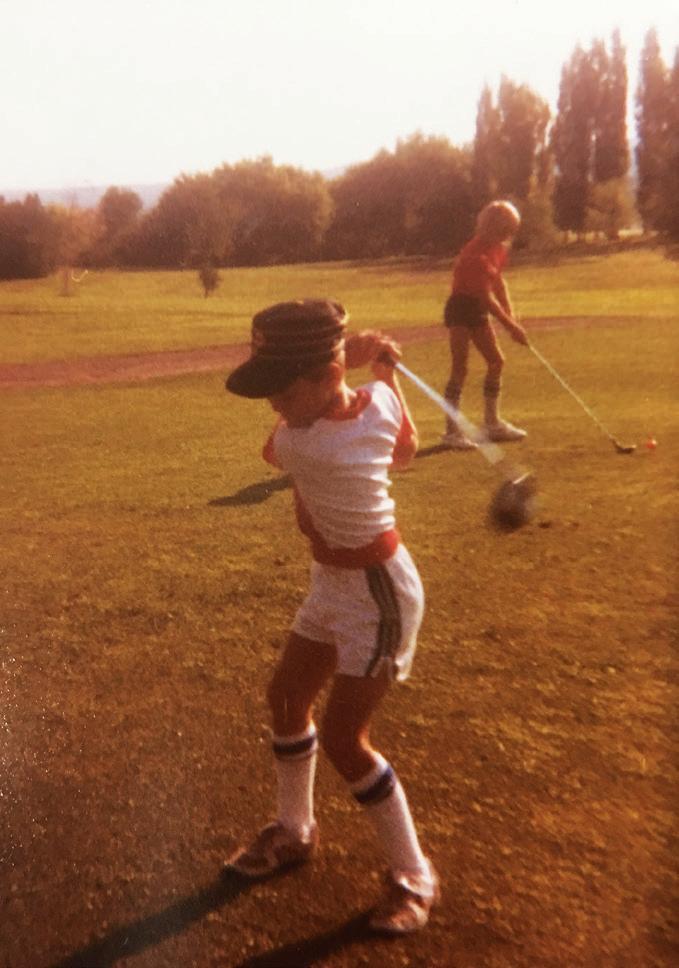
34 minute read
GREG ROBERTSON
ooted STORY BY RYAN CAMERON in Stillwater
How long did it take first-year Cowgirl head coach Greg Robertson to earn sweat equity in Oklahoma State and its golf programs?
Less than 48 hours.
On an August Friday in 1993, Robertson arrived in Stillwater via New Mexico to begin his collegiate journey, staying with teammate Billy Brown.
“The first night I got into town, he told me to make sure and wear some clothes I could get dirty. We had to be at the golf course in the morning so we didn’t really know what we were going to be doing,” Robertson said.
The Cowboys’ future home, Karsten Creek, was under construction at the time. Therefore, any team members in town preparing for the start of the academic year and not competing in the summer’s final amateur events spent the majority of that Saturday laying sod on the course’s closing hole.
“We basically laid half or two-thirds of the 18th fairway,” Robertson said. “It was 90-something degrees and humid and we hated everything about it, but you look back on it now and it was a pretty cool thing we did.”
To this day, the satisfaction from a hard day’s work and the lessons gained from it still exist for Robertson.
“It was good, and it is what Coach Holder is all about, having an appreciation for what you are a part of,” Robertson said.
“Any time we hit a shot on 18, I think we may have laid that piece of sod right there, and I have a bit more appreciation for what we have here.”
— Greg Robertson
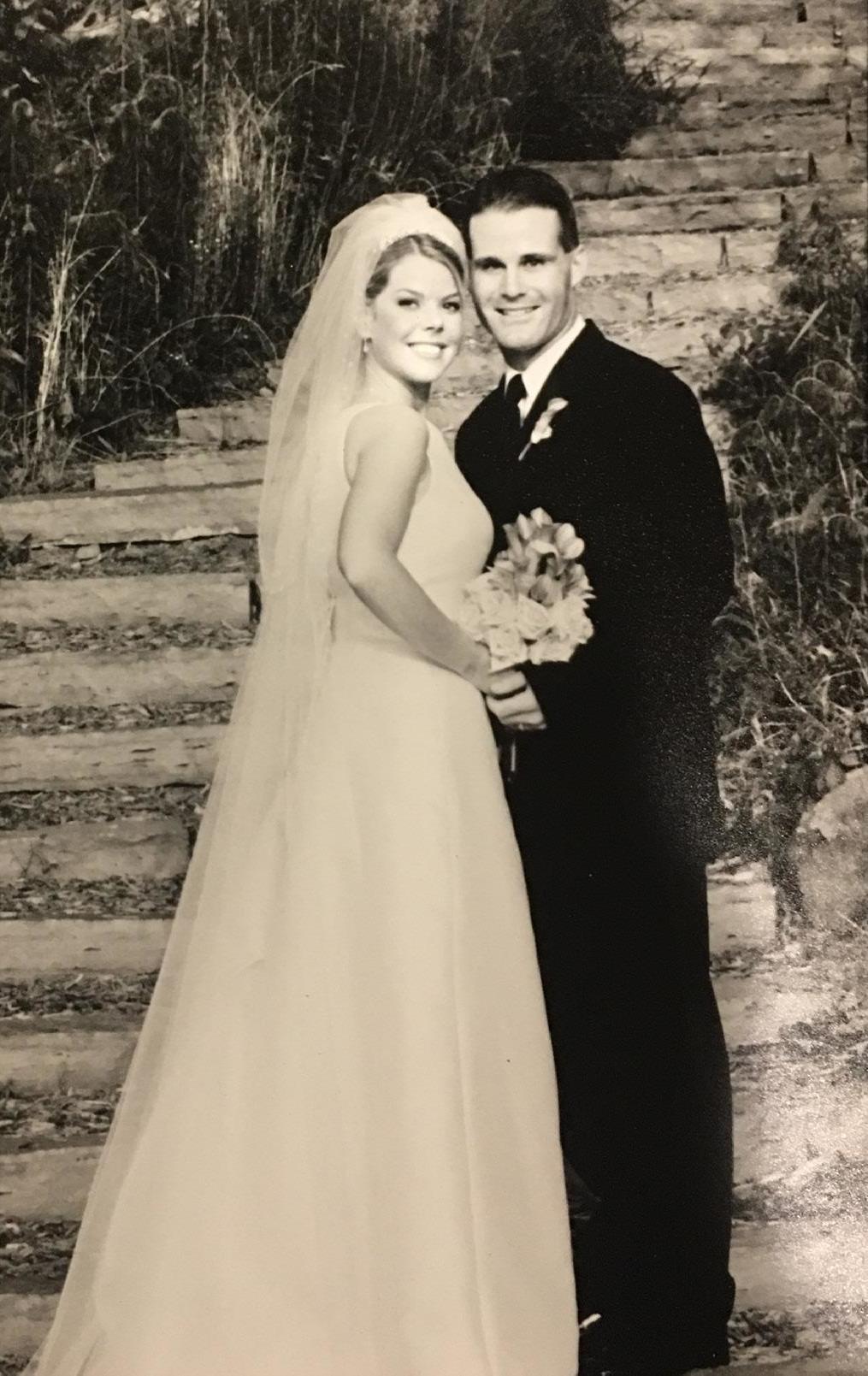
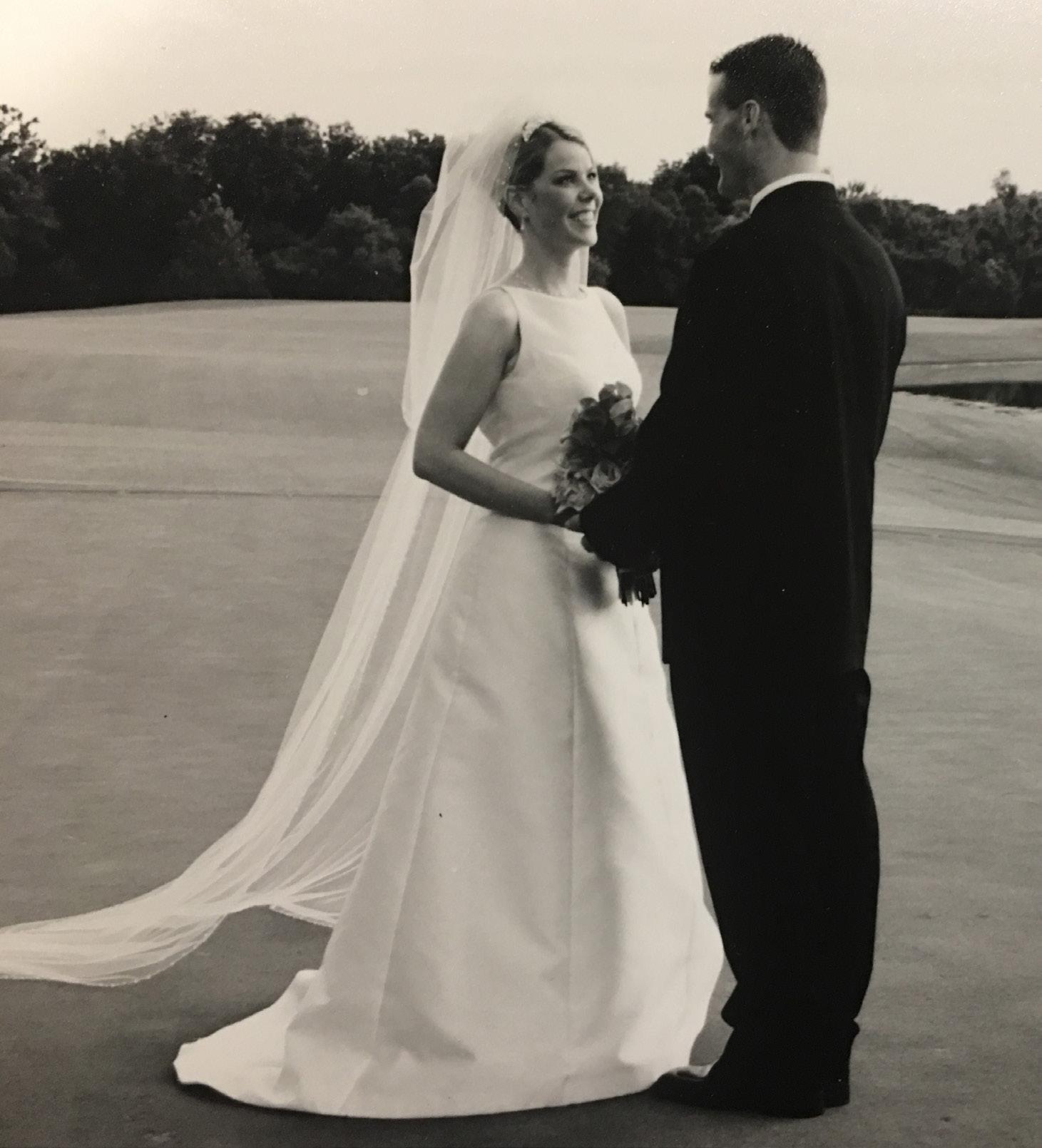
Robertson developed such an appreciation for Karsten Creek, it was the chosen site for one of his most significant life moments — his wedding. With the turf he helped lay as part of the picturesque backdrop, he married his wife, Ashlee, on July 12, 2003, on the patio overlooking Lake Louise.
“Karsten Creek and Oklahoma State were special places for me. My wife grew up in Stillwater and went to school at Oklahoma State. Her dad was a professor at Oklahoma State. Both of us had a lot of ties and love for Stillwater and for Oklahoma State, and this place was special to me,” Robertson said.
“The setting made it even better, getting to spend one of the most important and best days of your life at a place you love. Everything about it, having spent four years here and being special in terms of golf, and to have your wedding in the same place is pretty cool.”
Before he could find his way to the backdrop that would set the course for his future, he first had to find his way to the golf course. So what was it that drew Robertson to the game? The competition? The pursuit of victory? The satisfaction of a well-struck shot?
None of the above. Rather the distinct sound of metal spikes meeting the concrete cart paths proved to be the lure.
“When I was young, probably five- or sixyears-old, my parents played,” Robertson said. “I loved the sound they made on the ground so I told my parents that I wanted some of those shoes. They told me if I got into it and played, they would get me some of those shoes.”
With the spikes providing the initial hook, the game eventually sealed the deal and provided the Robertsons a chance to spend time together as a family. With both parents being educators, the end of the school day meant everybody was available at the same time to hit the links.
“The golf course was right across the street from where my dad was the elementary school physical education coach so we would go to the golf course. There was a little triangle where we could play three holes and come back to the clubhouse. We would go out there as a family and play three holes,” Robertson said.
From three holes with the family, Robertson progressed to tournament golf as an eightyear-old before graduating to national events a few years later. At the high school level, Robertson won a pair of state championships at New Mexico Military Institute and was twice runner-up.
While consistently finding himself in the top five on the leaderboard and advancing to match play at the U.S. Junior Amateur Championship, Robertson began to gain the attention of college programs. However, one coach in particular showed interest, and the decision was essentially made.
“When I was younger, I knew about the tradition and the program at Oklahoma State. It wasn’t until I got that initial letter from Coach Holder that it became real. Once I got the letter from him, from that point I was mostly in with Oklahoma State,” Robertson said.
“I took visits to Oklahoma State, New Mexico and UTEP and had one set up for UNLV. After my visit here, I decided this was the place to go.”
JOJO ROBERTSON

Already well versed in the history of the Cowboy program, when Robertson saw with his own eyes the future, the past and what it truly had to offer, he knew Stillwater was home.
“For me when I got here, Karsten Creek was just being built. Coach Holder took me out and the holes were cut out of the trees and there was no grass on them so you kind of had to visualize what was going on. He showed me his vision for the course and the plans and the layout,” Robertson said.
“When I saw the national championship trophies and the All-America plaques, I knew this is where I wanted to be.”
Following his collegiate career, Robertson’s transition to the coaching profession was not immediate. Multiple trips to Qualifying School, a season on the Canadian Tour and a start at the PGA Tour’s Nissan Open would come first.
“I gave it a shot for a couple of years and got to the second stage of Q-School. I have always had an interest in coaching, and as I was getting into my last year of playing and having given it a shot for a couple of years, it is not easy. I was kind of thinking I need to have a Plan B because I don’t want to be a 38-yearold playing mini tours,” Robertson said.
After seeing the University of Florida had a volunteer assistant on its staff, Robertson made a phone call to his former head coach in Stillwater and expressed interest in getting his career started. Holder agreed, and Robertson’s new career plan began to take shape.
Robertson spent time working in the golf shop at Karsten Creek as well as with the OSU men’s team. The following summer, a series of events would begin which would ultimately lead Robertson back to Stillwater.
Purdue’s Devon Brouse had an opening for an assistant coach, and it just so happened he crossed paths with Holder on the recruiting trail and asked if he had any suggestions for the position. The OSU head coach did, and Robertson had landed his first coaching gig.
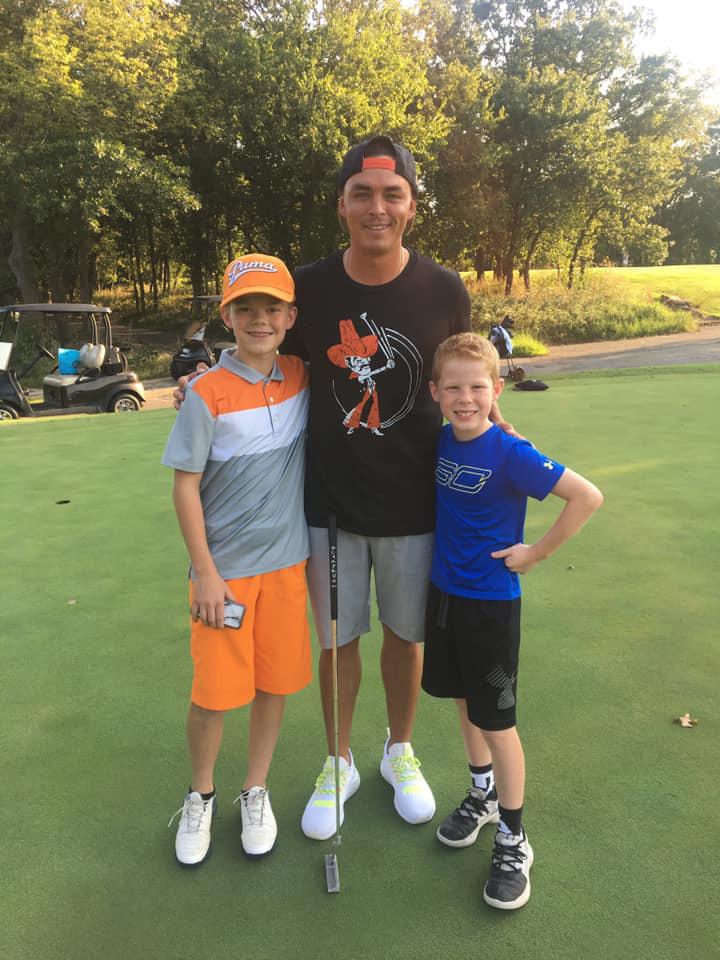
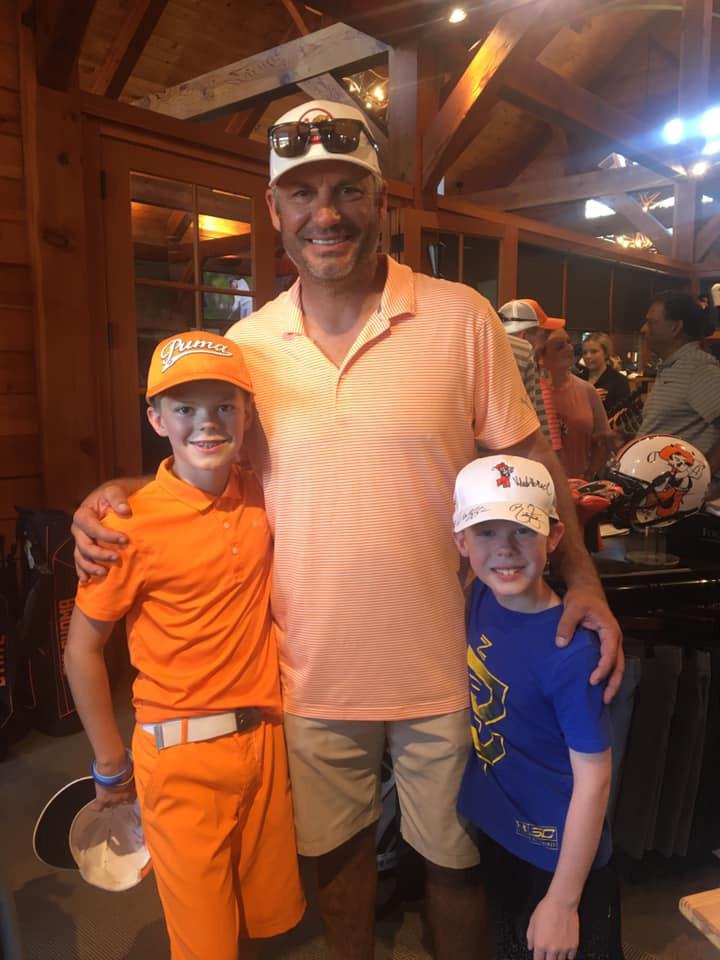
In West Lafayette, Robertson was given the title of associate head coach, which would be key to his future as well. In that role, Robertson would spend time working with both the men’s and women’s programs. To that point, he had solely focused on working on the men’s side. However, the women’s program was enjoying immense success, and Brouse urged him to spend more time at their practices and accompany them to tournaments.
“I really was only working with the guys. To be honest with you, that was all I really wanted to do,” Robertson said. “After I started spending time with the women’s team, I started to realize it was fun, and I enjoyed working with them.”
Near the end of a decade-plus run of success that included a national championship in 2010, five Big Ten crowns and 16 All-America selections, the next meeting of chance would occur and bring Robertson one step closer to Stillwater.
The head coaching position at Kent State had opened mid-year, and Robertson assumed the next coach was already lined up. Therefore, he did not pursue the post.
However, while inputting scores during Purdue’s event that spring, he overheard Kent State coach Herb Page’s inquiry to Brouse about potential candidates. Immediately upon finishing his tournament duties, Robertson zipped an e-mail to Page to express his interest.
Within days, Page contacted Robertson.
“I told him I would drive over there right then if he wanted me to. He said he would bring me in after the conference championship, which was about a week later. So I went over, they offered me the job, and I took it,” Robertson said. “Had I not heard that and waited any longer, they were getting ready to make their decision in the next day or two.”
Robertson doesn’t just consider himself fortunate in the circumstances that have shaped his career path. He counts himself lucky in that every step along the way he has drawn from some of the greatest names in the history of college golf.
In addition to competing for the man he describes as “the best golf coach who ever lived” in Mike Holder, Robertson learned from former OSU assistant Bruce Heppler, who has gone on to a highly successful head coaching career at Georgia Tech. Upon graduating from OSU, Robertson spent his final year of eligibility under J.T. Higgins at New Mexico, who has a national championship on his résumé.
Mix in coaching stints with former Cowboy head coach Mike McGraw, Brouse and Page, and you realize Robertson has had an encyclopedia’s-worth of knowledge at his disposal as he has skyrocketed through the coaching ranks.
“If you take all of those coaches that I got to spend time around playing for, working with or working under, I don’t know if anybody else has had that kind of experience that I have been fortunate enough to have,” Robertson said. “There are a lot of different ways to coach and a lot of different ways to do things. It has been an unbelievable ride for me and what I have been able to learn along the way.”
In his six seasons as head coach at Kent State, Robertson put that knowledge to good use, winning 27 tournament titles, including six Mid-American Conference championships. He led the Golden Flashes to three consecutive NCAA Championships, where they advanced to match play twice. Only the top eight finishers in stroke play advance to match play, the final stop on the road to the national championship.
You do not have to look far to see why Robertson was destined to be a coach and a successful one at that. In addition to the list of legends he has coached or played under, Robertson’s father, Andy, was a high school football coach, while his mother, Becky, served as a high school golf coach. His sister, JoJo, enjoyed a decorated career at OSU and has gone on to a successful run as head coach of the Texas Tech women’s program.
“As a family, honestly the best coach in our family is my mom. She coached high school golf in New Mexico for 16 years, won 14 state championships and finished second twice,” Robertson said.
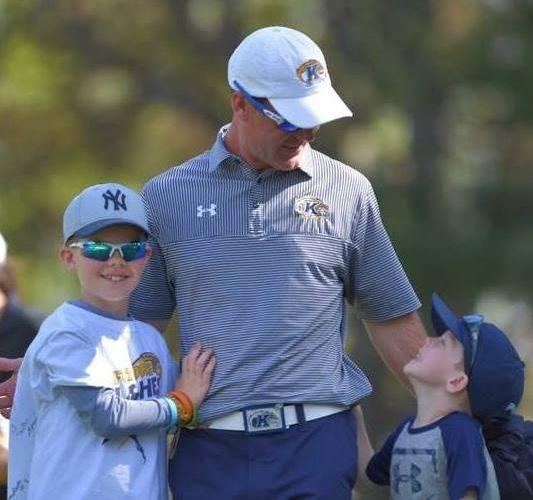
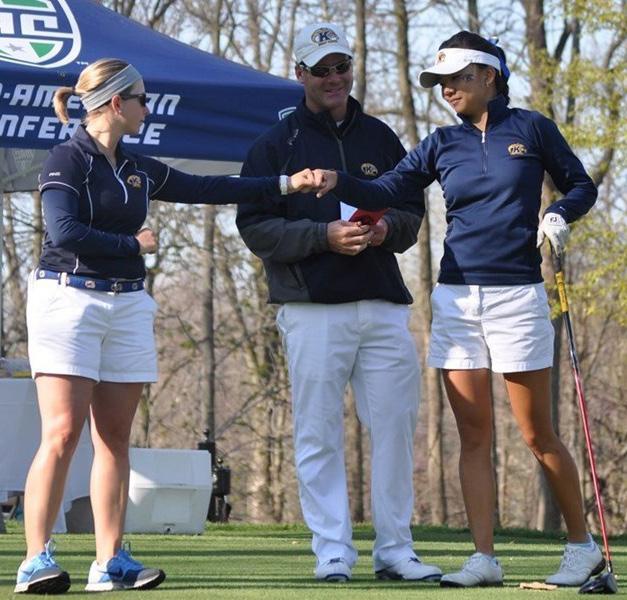
MADDI SWANEY
“Coming from a coaching family we all try to help each other out. We all pull for each other and from each other, and we are always sending as a group anything we find about coaching to each other.”
Cowboy head coach Alan Bratton vividly recalls Robertson’s recruiting visit and witnessing a coach in the making.
“We went to the football game, and I can remember sitting with him and he was calling the plays from the stands. He knew this is a run, this is a pass after watching one series from the opposing team. He knew something in their scheme, and I remember being fascinated by that,” Bratton said.
“Having coaching in your blood and that competitiveness and work ethic all point to him being a really good coach.”
And while the thought of returning to Stillwater may have been in the back of his mind, Robertson maintained tunnel vision and stayed locked on the task at hand.
“When I was at Kent, we were just doing our thing, and I never thought about where I was going to go from there. We were just focused on doing the best we could and trying to win a national championship there,” Robertson said. “In the end, this job opened up, and for me and my family it’s a perfect situation.”
In his efforts to carry over the momentum of his success at Kent State, Robertson landed a key recruit in the form of assistant coach Maddi Swaney. Robertson inherited the young assistant upon taking the job with the Golden Flashes and quickly realized retaining her was the right choice and a key ingredient to the successes he has had.
“When I first got there, they told me I could hire whoever I wanted. They told me she was a hard worker, and I thought I will try this for a year. She knew everything about Kent State. It was the best decision I ever made,” Robertson said.
To elevate the OSU program, Robertson has emphasized the importance of being able to bring his trusted assistant into the fold.
“For the level of success we had at Kent State and what we are trying to get done here, she was 100 percent a part of what we have done. So for me to be able to bring her here and hit the ground running and keep that continuity is huge,” Robertson said.
“I have let her become her own coach, and I trust everything she does. I would not be where I am without her.”
Where he is now is a place with lofty standards, and Bratton expects his former teammate to thrive because of his familiarity, his track record elsewhere and the resources now available to him.
“There is a comfort level for him because he is coming home. He understands the expectation. He has benefitted from knowing he could do it somewhere else. He took Kent

State to a level they had never been to with their women’s program so there is a confidence that what he knows and what he believes and values works anywhere,” Bratton said.
“Now he gets to come back where you have support and a fanbase that loves golf like nowhere else.”
Not only does Bratton believe Robertson will take the Cowgirls to unprecedented heights, he feels both programs will fuel each other.
“I draw from Donnie (Darr) a lot because he has coached at other places. I only know here, so collectively, Maddi and Greg bring another outside influence as well. He has played for and worked for other coaches at other universities. That adds value, and I can learn from them both. We can learn from each other and share ideas, get better and not get stale,” Bratton said.
As Robertson begins to put his fingerprints on the Cowgirl program, he agrees knowing the Cowboys have long been the standard in college golf will benefit him in his efforts.
“What I have wanted to do from day one is try to pull from the men’s side. The success that they are having does nothing but help us out and vice versa. If we are both playing at a high level, it just validates the quality of the program you have here and that you can get it done here,” Robertson said.
“Everything I know about this place you can be successful, you can recruit the best, you can get the best and you can have the best team in the country.”
When OSU announced its scholarship endowment initiative, the athletic program was last in the Big 12. Now, more than halfway through the 10-year program, OSU leads the conference.
But we’re not finished yet.
OSU awards 229 full scholarships to studentathletes each year at a cost of $4.5 million. Each dollar freed up through endowed scholarships goes back into our programs. Better equipment. Better facilities. Better support. Each dollar has a direct impact on the lives of our student-athletes.
“Each scholarship we endow secures the future of OSU athletics and provides more opportunities for our student-athletes on and off the field,” says Mike Holder, Vice President for Athletic Programs and Director of Intercollegiate Athletics.
This is the list of all the generous supporters who have helped to provide a bright orange future.

They are our Honor Roll.
PHOTO / BRUCE WATERFIELD
Baseball 10.25
Full Scholarship
Dennis and Karen Wing (2) | Hal Tompkins
Sandy Lee | Jennifer and Steven Grigsby
Mike Bode and Preston Carrier (2)
David and Julie Ronck
Half Scholarship
Sally Graham Skaggs
Quarter Scholarship
Bryant and Carla Coffman
David and Grace Helmer | Jill Rooker
Martha Seabolt | Dr. Scott Anthony John and Beverly Williams
Richard and Lawana Kunze
Equestrian 1.25
Full Scholarship
Baloo and Maribeth Subramaniam
Quarter Scholarship
David and Gina Dabney
Football 33.0
Full Scholarship
Bob and Kay Norris
Bryant and Carla Coffman / The Merkel Foundation
David LeNorman | Dennis and Karen Wing (2)
Dr. Mark and Beth Brewer Jack and Carol Corgan Jim Click | John and Gail Shaw
Ken and Jimi Davidson | Leslie Dunavant
Mike and Kristen Gundy
Mike and Robbie Holder
Ron Stewart | Ross and Billie McKnight
Sandy Lee | Tom and Sandra Wilson
Wray and Julie Valentine James and Mary Barnes
Half Scholarship
Cindy Hughes | Donald Coplin
Doug Thompson | Ed and Helen Wallace
Greg Casillas | Ike and Marybeth Glass Jim and Lynne Williams / John and Patti Brett
Mike and Judy Johnson | Sally Graham Skaggs
State Rangers | Tom Naugle | Nate Watson
Quarter Scholarship
Al and Martha Strecker
Arthur “Andy” Johnson, Jr.
Arthur Couch | Barry and Roxanne Pollard
Bill and Ruth Starr | Brad and Leah Gungoll
Brian K. Pauling
Bridgecreek Investment Management LLC
Bryan Close | David and Cindy Waits
David and Gina Dabney | Dr. Berno Ebbesson
Dr. Ron and Marilynn McAfee
Eddy and Deniece Ditzler | Flintco
Fred and Janice Gibson | Fred and Karen Hall Howard Thill | James and LaVerna Cobb Jerry and Lynda Baker | Brent Wooten Jerry and Rae Winchester | John P. Melot John S. Clark | Ken and Leitner Greiner Kent and Margo Dunbar | Paul and Mona Pitts R. Kirk Whitman | Randall and Carol White Roger and Laura Demaree | Shelli Osborn Steve and Diane Tuttle Tony and Finetta Banfield
General 1.25
Half Scholarship
Terry and Martha Barker
Quarter Scholarship
David and Judy Powell
Kenneth and Susan Crouch
Sally Graham Skaggs
Graduate Athlete 0.75
Quarter Scholarship
Bob and Joan Hert | Neal Seidle
Tom and Cheryl Hamilton
Men’s Basketball 23.5
Full Scholarship
Baloo and Maribeth Subramaniam
A.J. and Susan Jacques
Bill and Marsha Barnes
Brett and Amy Jameson
Calvin and Linda Anthony
Chuck and Kim Watson
David and Julie Ronck (1.25)
Dennis and Karen Wing (2)
Douglas and Nickie Burns
Griff and Mindi Jones James and Mary Barnes | Jim Vallion
Ken and Jimi Davidson
Kent and Margo Dunbar | KimRay Inc.
Sandy Lee | Mitch Jones Memorial
Half Scholarship
David and Julie Ronck
Dr. Mark and Susan Morrow Jay and Connie Wiese | Sally Graham Skaggs
Stan Clark | Billy Wayne Travis
Holloman Family
Quarter Scholarship
Dr. Scott and Lynne Anthony
Gary and Sue Homsey
Michael and Heather Grismore
Rick and Suzanne Maxwell
Robert and Sharon Keating
Steve and Suzie Crowder
Terry and Donna Tippens
Men’s Golf 5.25
Full Scholarship
David and Julie Ronck
Dennis and Karen Wing Jack and Carol Corgan Men’s Golf Scholarship
Baloo and Maribeth Subramaniam
Half Scholarship Simmons Bank
Quarter Scholarship
Bob and Elizabeth Nickles
Garland and Penny Cupp
Richard and Joan Welborn
Men’s Tennis 0.75
Quarter Scholarship
Tom and Cheryl Hamilton
Half Scholarship
Jim McDowell Men's
Men’s Track 0.75
Quarter Scholarship
Dr. Mark and Susan Morrow
Susan Anderson | Ken and Leitner Greiner
Soccer 1.0
Full Scholarship
James and Mary Barnes
Softball 0.75
Quarter Scholarship
Tom and Cheryl Hamilton
Richard Melot
Ann Dyer
Women’s Basketball 7.25
Full Scholarship
Brad and Margie Schultz
Ken and Jimi Davidson
Mike Bode and Preston Carrier
Half Scholarship
Baloo and Maribeth Subramaniam
Don and Mary McCall John and Caroline Linehan
Calvin and Linda Anthony
Mike Bode and Preston Carrier
Quarter Scholarship
Bill and Roberta Armstrong
Bill and Sally Cunningham
Donald Coplin | Jill Rooker
Richard and Linda Rodgers Jo Hughes and Deborah J. Ernst
Richard Melot
Women’s Golf 2.0
Full Scholarship
Baloo and Maribeth Subramaniam
Half Scholarship
David and Julie Ronck
Quarter Scholarship
Amy Weeks | Kent and Margo Dunbar
Women’s Tennis 0.5
Quarter Scholarship
Jamie Maher
Richard Melot
Wrestling 10.75
Full Scholarship
A.J. and Susan Jacques
Bruce and Nancy Smith
Chuck and Kim Watson
Lon and Jane Winton
OSU Wrestling – White Jacket Club / Gallagher Endowed Wrestling Scholarship
OSU Wrestling – White Jacket Club / Myron Roderick Endowed Wrestling Scholarship
OSU Wrestling – White Jacket Club / Ray Murphy Endowed Wrestling Scholarship
OSU Wrestling – White Jacket Club / Tommy Chesbro Endowed Wrestling Scholarship The Cobb Family
Half Scholarship
Mark and Lisa Snell
Bobby and Michelle Marandi
Quarter Scholarship
Danny and Dana Baze / Cory and Mindy Baze John and Beverly Williams | R.K. Winters
To learn more about scholarship opportunities and how you may contribute, please contact:
Larry Reece (405-744-2824) Matt Grantham (405-744-5938) Shawn Taylor (405-744-3002)
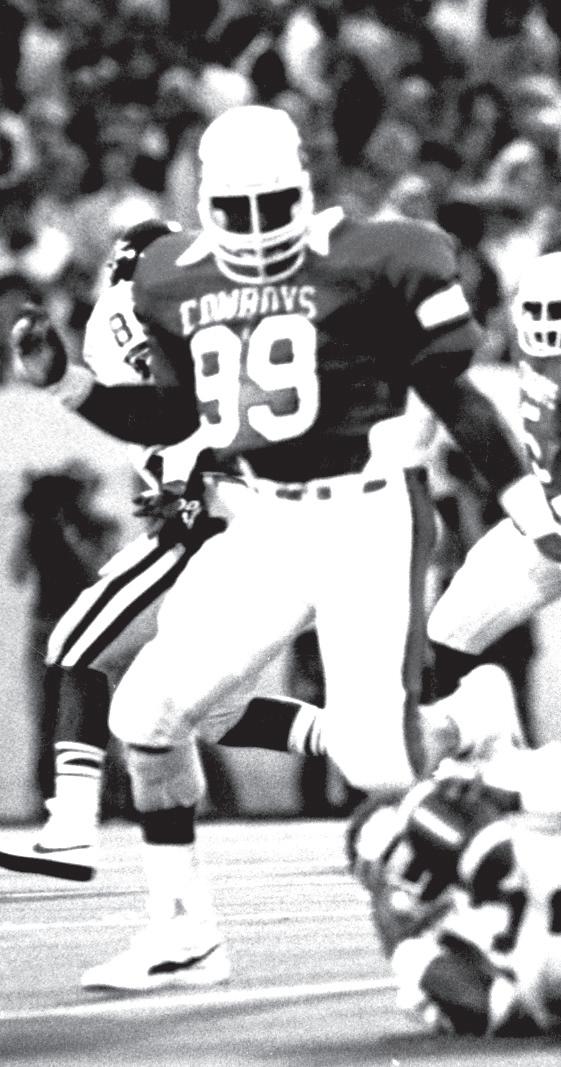
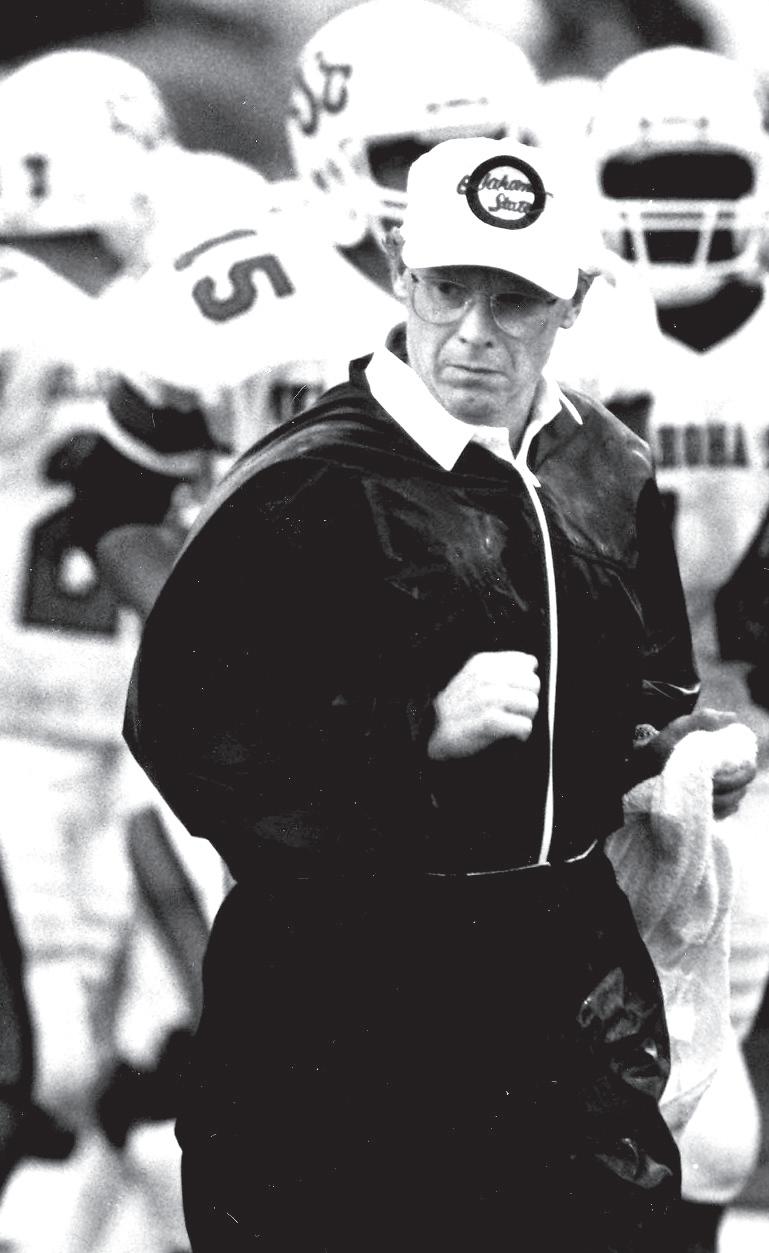
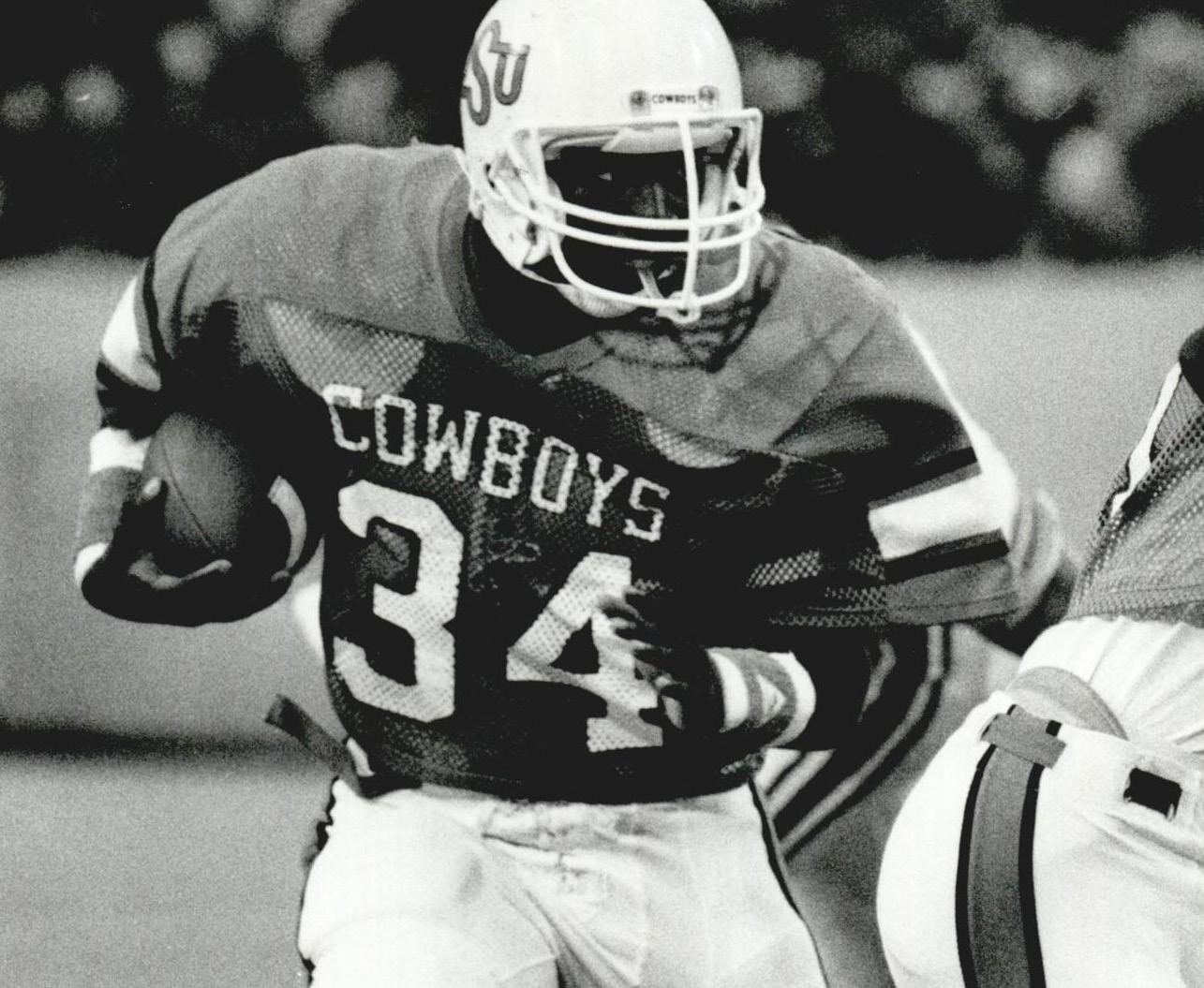

Hanging Ten the First Time
STORY BY TOM DIRATO
Oklahoma State fans were still celebrating the Cowboys’ New Years Eve Bluebonnet Bowl win over Baylor (24-14) when the
rumor mill started to spin. A number of college programs were zeroed in on Jimmy Johnson, who in five years produced 30 wins and two bowl teams while calling the shots in Stillwater.

Some of the rumors were just that — false speculation. But, the University of Miami was serious about luring Johnson, who came to Oklahoma State from Pittsburgh and quickly energized a fan base with his “Press On” attitude.
Johnson hit the ground running. He brought coaches to OSU from Pitt. The Cowboys posted a 7-4 record (5-2 in the Big Eight) in year one, and he took the Cowboys to the Independence Bowl in 1981 and to the Bluebonnet Bowl two years later. Excitement was back in Stillwater. Oklahoma State finished with an 8-4 record in 1983, and the Cowboys would be returning many of the key players in ’84.
But, the chance to coach in the Sunshine State proved to be too much for Johnson. He took the Miami job and left those in and around the Oklahoma State football program asking what now? Who would be the next head coach? How long would the search process take? How far would the administration look to find a replacement?
LARRY COKER
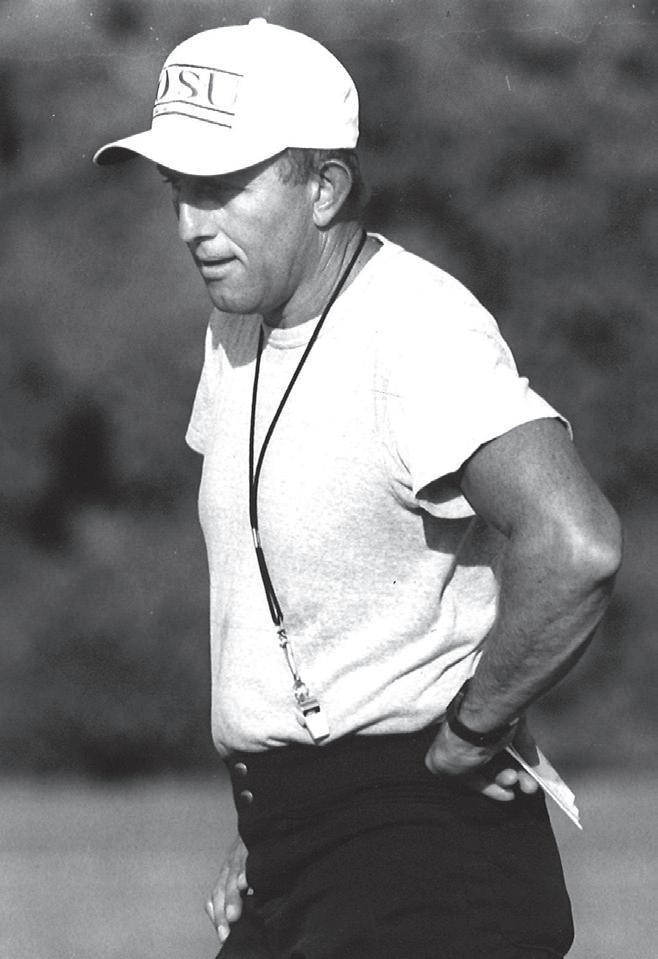
HOUSTON NUTT
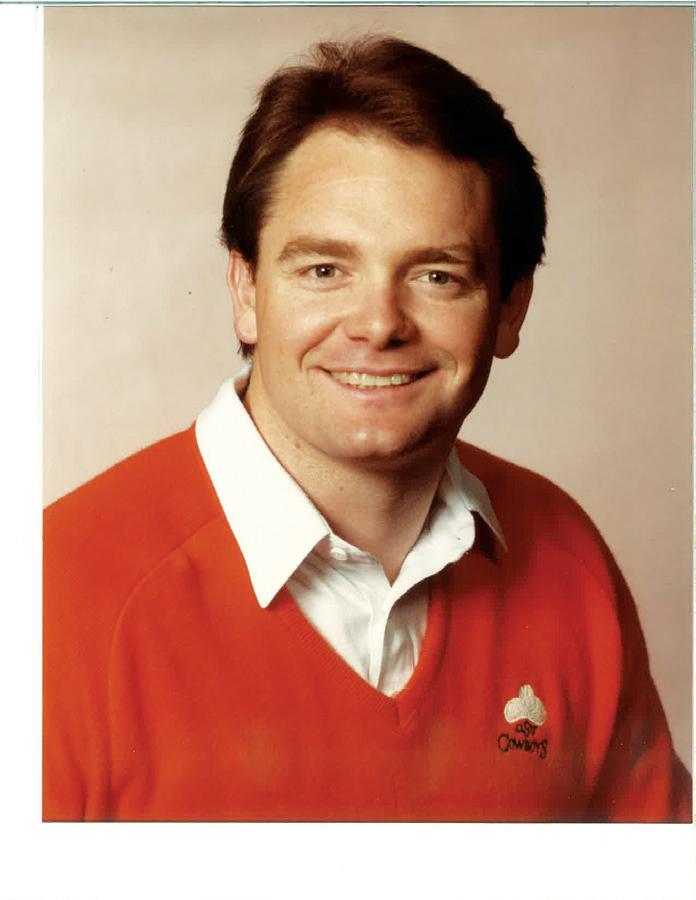
Spring had turned to summer. The off-season workouts were well underway. Recruits were left wondering who their next head coach would be. Time was of the essence.
Athletic director Myron Roderick was on top of the situation from the jump. As soon as it became obvious that Johnson was serious about listening to other offers, Roderick, a former NCAA championship wrestling coach and wrestler, quickly came up with a list of coaches he would target to become Oklahoma State’s 19th football coach.
But, a meeting with several of the Oklahoma State players early in the process turned out to be just what Roderick was looking for. In fact, his next coach was sitting in an office in the OSU football complex. Erwin Patrick Jones, OSU’s hard-nosed defensive coordinator, was a clear-cut choice.
“Pat was a player’s coach,” recalled former linebacker Matt Monger. “We went to the AD and told him he was our choice. We were all behind him.”
So, slightly more than 48 hours after Johnson departed, the University’s Board of Regents acted on the appointment of Jones. And, a golden era of Cowboy football was underway.
“Obviously, I was very excited about getting the job,” Jones would say after his first press conference. “But, what really thrills me … actually overwhelms me, is the way the university community rallied behind the program and me.
“The quick and unanimous support of the administration, friends, alumni, players, coaches, just everybody involved, might have drawn this program closer together in that respect than at any other time.”
Tributes poured in from every corner of the coaching world. Frank Broyles, former coaching great at Arkansas and the Razorback AD at the time said, “Pat has very striking and engaging qualities. They lend themselves to be an excellent football coach. He has prepared himself diligently for this role. Anyone who knows him recognizes he is ready for the challenge of being a head coach.”
Perhaps the most impressive sign of support came from the coaching staff. Despite chances to leave, the staff remained almost intact to bolster a team that returned 16 starters from that ’83 Bluebonnet Bowl team. The staff read like a Who’s Who of coaches. George Walstad stayed on as assistant head coach and defensive line coach. The offensive coordinator and quarterbacks coach was Larry Coker. Other notables included Brad Seely (offensive line), Reggie Herring (linebackers), Kevin Steele (tight ends) and Houston Nutt (receivers).
I spent a lot of hours with Pat and his staff over his 11-year stay. He became the winningest coach in OSU history (now second behind Mike Gundy) and finished with a 62-60-3 record. He took OSU to four bowl games. Pat was always an intense football coach. Perhaps that came from his days at Hall High School in Little Rock, where he was an all-state guard on a state championship team. Because he lacked the size to attract a lot of what we now know as Power Five offers, he spent his first college season as a nose guard on Arkansas Tech’s 7-3 team.
He transferred to Arkansas the next year as a walk-on linebacker and guard. Ankle injuries plagued him in Fayetteville and ultimately turned the self-proclaimed “gym rat at heart” to coaching. He spent a successful five years at Hall High School (won two state titles) then joined the Razorback staff as a graduate assistant.
Jones was named defensive line coach at Arkansas in 1975 by Broyles. He spent two years with coach Ron Meyer at SMU before joining Jackie Sherrill in Pittsburgh as defensive line coach.
“The only thing I ever wanted to do in life was coach football,” he would tell me many times over the years. “I consider this the greatest opportunity of my life. Of course, I’m no better than the men behind me. Our coaches and players know how to win. And we will continue
to win games. I’ve never felt any other way and I don’t see any reason to change now.”
Armed with a new head coach, a solid staff of assistants and a roster of talented football players, Oklahoma State jumped into the 1984 season. It would be one of the most significant campaigns in the long history of Cowboy football. It began with a stunning 45-3 win over 12th-ranked Arizona State in Tempe and ended with a thrilling down to the wire 21-14 victory over No. 7 South Carolina in the 40th annual Gator Bowl.
OSU finished 10-2 (5-2 in the Big Eight). It was the first 10-win season for the Cowboys and the first of three such seasons Oklahoma State would roll up over Jones’ first five years at the helm. In fact, the Cowboys posted identical 10-2 seasons back to back in 1987 and 1988. And, keep in mind that’s when teams were only playing 11 regular season games.
Arizona State was predicted to be a national championship contender by Sports Illustrated prior to the 1984 season. The Cowboys didn’t care. In a smashing debut for Jones, OSU crushed the Sun Devils 45-3 behind the running of tailbacks Charles Crawford and Shawn Jones, the on-target kicking of Larry Roach, the steady play of quarterback Rusty Hilger and a mauling defense led by the talented tackle tandem of Leslie O’Neal and Rodney Harding.
Crawford, a bruising back from Bristow, rolled up 137 yards and scored on 44-yard run; Jones added 101 yards on the ground; Roach kicked field goals of 32, 27 and 47 yards; Hilger passed for one score and ran for another; O’Neal and Harding led a fierce defensive effort that forced four interceptions and a fumble. A Sun Devil Stadium crowd of 70,244 watched as the Cowboys came out as hot as the 97-degree temperature at kickoff. The Pat Jones era was underway.
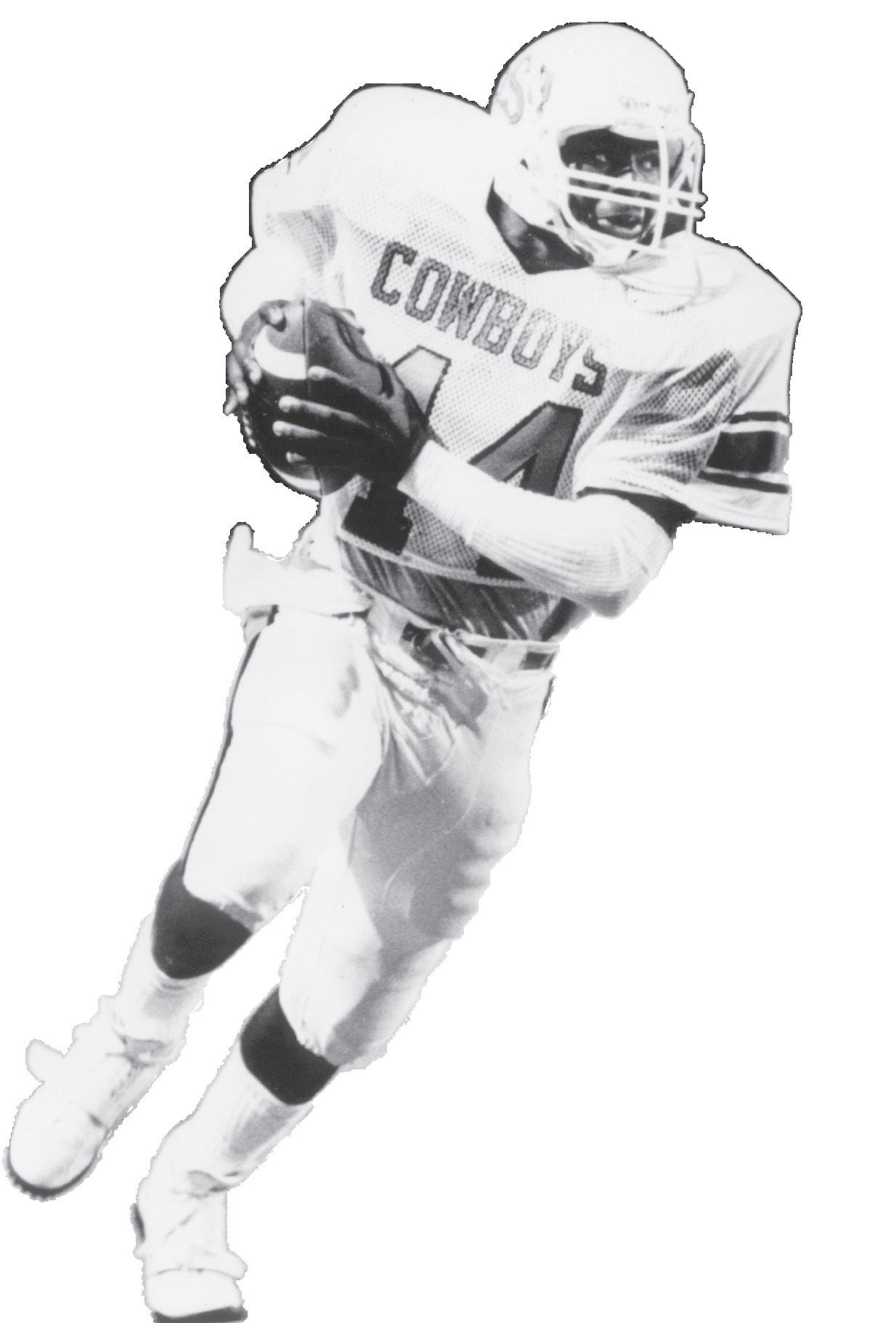
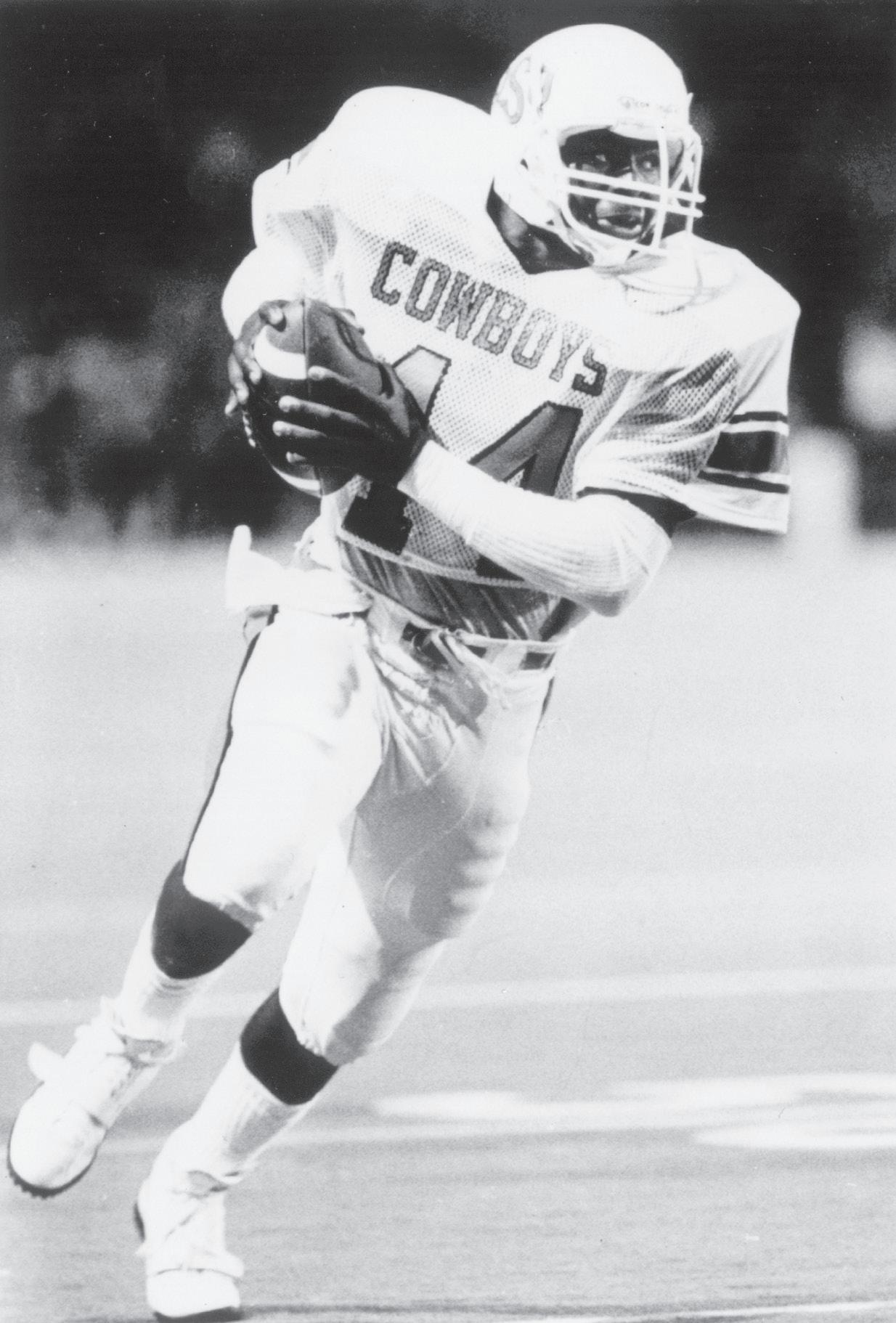
MARK MOORE
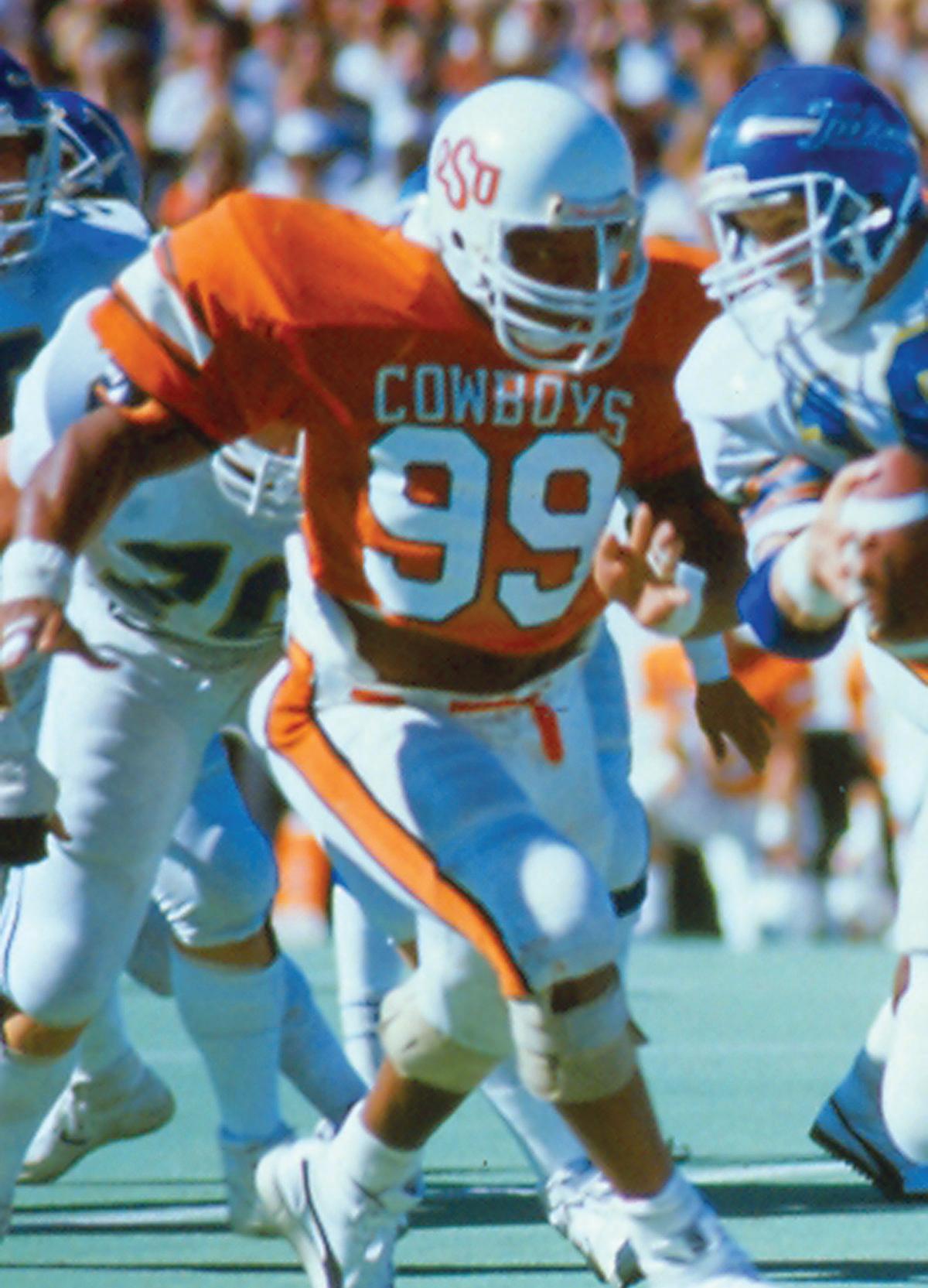
BARRY HANNA
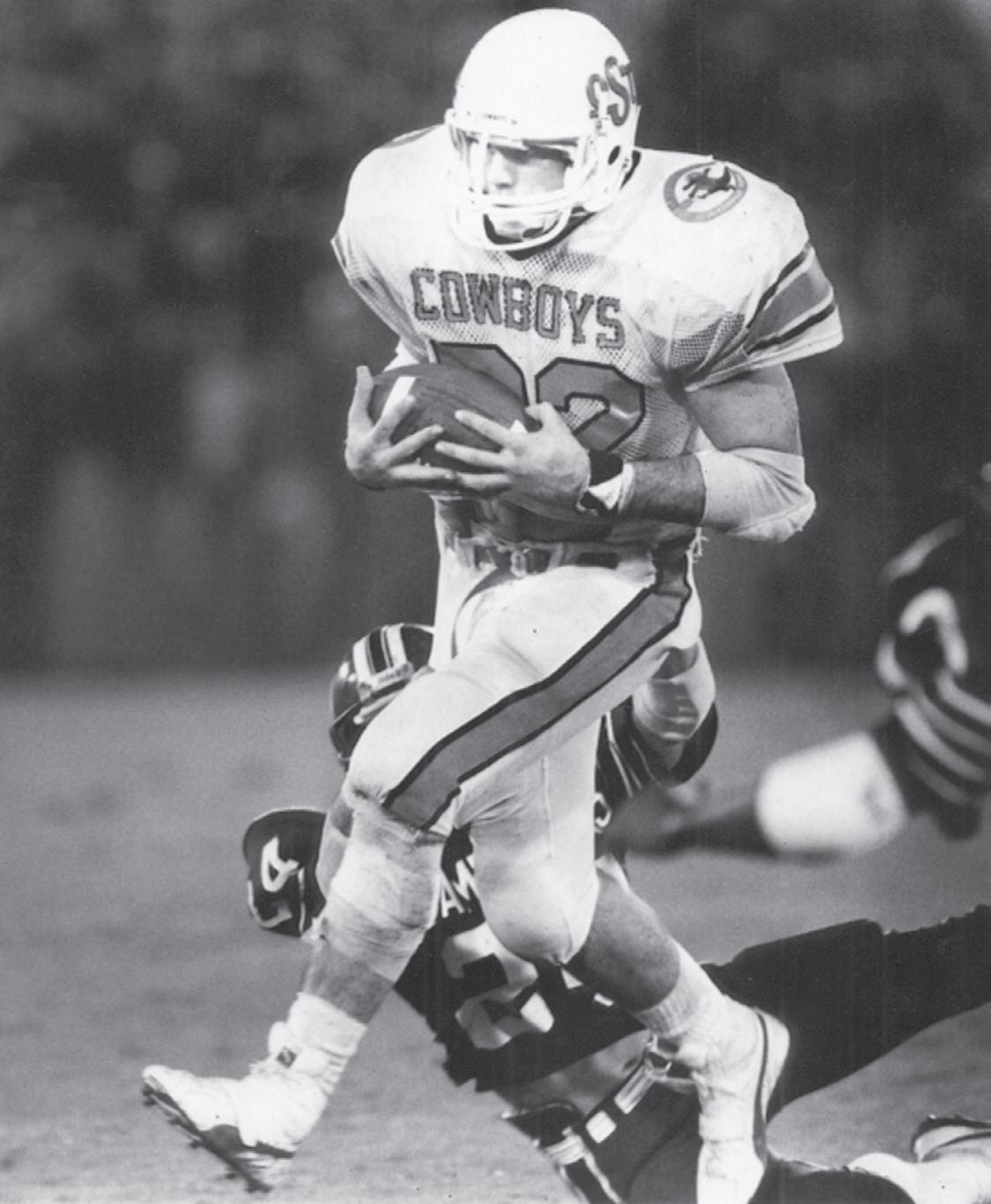
LESLIE O'NEAL
Bowling Green came to Stillwater the next week and Oklahoma State wasn’t near as sharp. It was a workman-like 31-14 win. OSU had two interception returns for a touchdown and Jones ran for 114 yards and a touchdown to win the game going away. Rod Brown had a spectacular 95-yard pick six that followed Mark Moore’s 17-yard TD interception return. Crawford hurt his knee and left the game. Thurman Thomas came on and rushed for 63 yards on 14 tries.
Oklahoma State had to survive against San Diego State the next weekend. The upsetminded Aztecs pushed OSU to the limit before the Cowboys won their third straight game. It took a crucial defensive play at the Cowboy two-yard-line with 98 ticks left on the Lewis Field scoreboard to preserve the win.
O’Neal tackled Chris Hardy at the two, Moore stripped the ball away and Jim Krebs recovered to hand the Cowboys a 19-16 win. OSU took a safety with 14 seconds left and had to weather a trick play on the ensuing kickoff to finally put the game away.
Oklahoma State journeyed to Tulsa the next weekend. A record Skelly Stadium crowd of 40,235 turned out to watch the 10th ranked Cowboys and turnpike rival Tulsa. This one was all OSU as the Cowboys led 21-0 at half and rolled to a 31-7 victory. It was the most lopsided win in the series since 1964.
The Cowboys had received some love from Sports Illustrated the week before, and there were some wondering whether they could play through the “jinx.” OSU had cracked the Associated Press top 10 for the first time in 39 years and SI featured the program in an article just days before the trip to T-Town.
Jones again shouldered the running load with 174 yards and two scores on 21 carries. Hilger threw for 149 yards and Thomas got into the act when he threw a halfback nine-yard TD pass to Jamie Harris to start the scoring.
O’Neal, Monger and Krebs made life miserable for the Tulsa offense.
“They kicked us pretty good,” admitted Tulsa coach John Cooper. “They are an excellent team … well coached.”
The season was on its way to becoming historic for Oklahoma State.
Ninth-ranked OSU opened the conference season in Lincoln against eighth-ranked Nebraska. It was big boy football for four quarters. The final score: Nebraska 17, Oklahoma State 3. But, it wasn’t that easy.
Nebraska scored all of its points in the final 15 minutes and Oklahoma State muffed three chances to score.
Husker Shane Swanson scored on a 49-yard punt return midway through the fourth quarter to create the separation the Huskers needed. A clipping penalty wiped out one OSU score, an end zone pick snuffed another chance, and a blocked 42-yard field goal thwarted yet another Cowboy score.
“You can’t win big ball games and get touchdowns called back,” said Jones on the post-game radio visit.
The loss, OSU’s first of the year, broke a six-game win streak, dating back to a defeat at Missouri in 1983.
Oklahoma State took out its Nebraska frustrations on Kansas the next week. Erupting for 551 yards, the Cowboys ripped out-manned Kansas 47-10. The 5-1 start by the Pokes was the best since 1945. At the time, the 551 yards represented the fifth largest total in OSU history and the second most rolled up against a Big Eight team.
Kenny Zachary led the way with 96 yards (87 on a touchdown run), Hilger threw for 139 yards and a score while Roach booted a pair of field goals. The game was over at halftime as OSU bolted out to a 31-3 lead.
Oklahoma State somehow overcame four lost fumbles, six crucial penalties and a long distance (80 yards) touchdown pass to ease
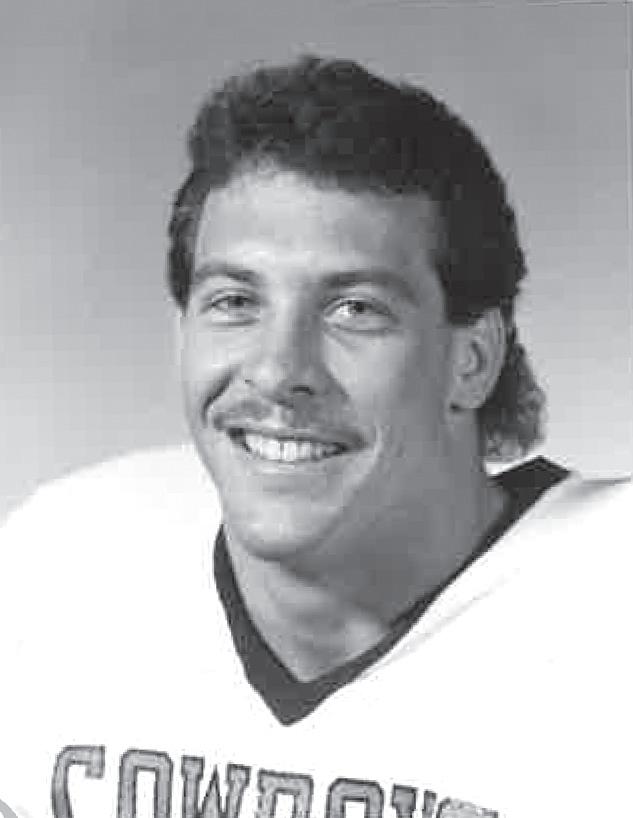
MATT MONGER
past Colorado the following weekend at Lewis Field. The final score (20-14) was every bit as close as it appeared.
The Cowboys used a safety, a 47-yard TD strike to Malcolm Lewis and a Roach field goal to climb to 6-1 on the year. Oklahoma State piled up 446 yards (265 on the ground), but the four turnovers kept the Cowboys from having any easy afternoon.
Third-string tailback Thurman Thomas took advantage of a big opportunity when the Cowboys journeyed to Manhattan to take on Kansas State. The Texan freshman made the most of extended playing time as he piled up 206 yards and two touchdowns to spark Oklahoma State to an easy 34-6 win. He carried the ball 34 times as he gave us all a hint of what his AllAmerica career was going to entail.
Roach kicked a 52-yard field goal. Hard hitting corner Mark Moore, who would also go on to earn All-America honors, scored on a 55-yard pick six as the Cowboys blew the game open with a 19-point second quarter.
K-State coach Jim Dickey said it all after the game.
“It’s obvious Oklahoma State is a very good football team, especially on defense. That Thomas, he’s got the ability. He cut back against the grain when we pursued and made good yardage. He’s going to be a great player.”
The big Bedlam battle in Norman was still two weeks away. Missouri and Iowa State would come calling before what would be a battle for the Orange Bowl took place at Oklahoma.
November 10, 1984, will always hold a special place his Cowboy football history. Not because OSU won a hard-fought 31-13 game, but because for the first time in 52 years Oklahoma State played a night game in Stillwater. I recall the excitement as we watched Musco bring in portable lights for a nationally televised game.
OSU and Missouri went back and forth for most of the game. O’Neal’s block of a Tiger field goal with 12 minutes remaining set up a short 36-yard scoring drive. Hilger connected with Jamie Harris after getting the ball back on a flea-flicker and the Cowboys extended the lead to 24-13. Missouri could’ve closed the score to 17-16 had O’Neal not overpowered a Missouri blocker to bat down the 33-yard attempt.
It looked like a heavyweight fight as Thomas ran for 101 yards and two touchdowns and Hilger threw for 235 yards and a score. Mizzou’s Jon Redd answered with a 96-yard night while talented quarterback Marlon Adler had a 194-yard game through the air.
Oklahoma State upped its record to 9-1 on a blustery, rainy, 39-degree day as Iowa State pushed the home team to the limit. It wasn’t until Windell Yancy knocked down a pass at the OSU 10 with 1:33 left fans could celebrate a hard-earned 16-10 win.
O’Neal and John Washington came up with one big defensive play after another to help out an offense that sputtered the entire afternoon.
The win was significant. It set up a Big Eight championship game in Norman against second-ranked Oklahoma. The winner would head to the Orange Bowl and keep its hopes alive for a national title. The loser would be headed to the Gator Bowl.
RUSTY HILGER
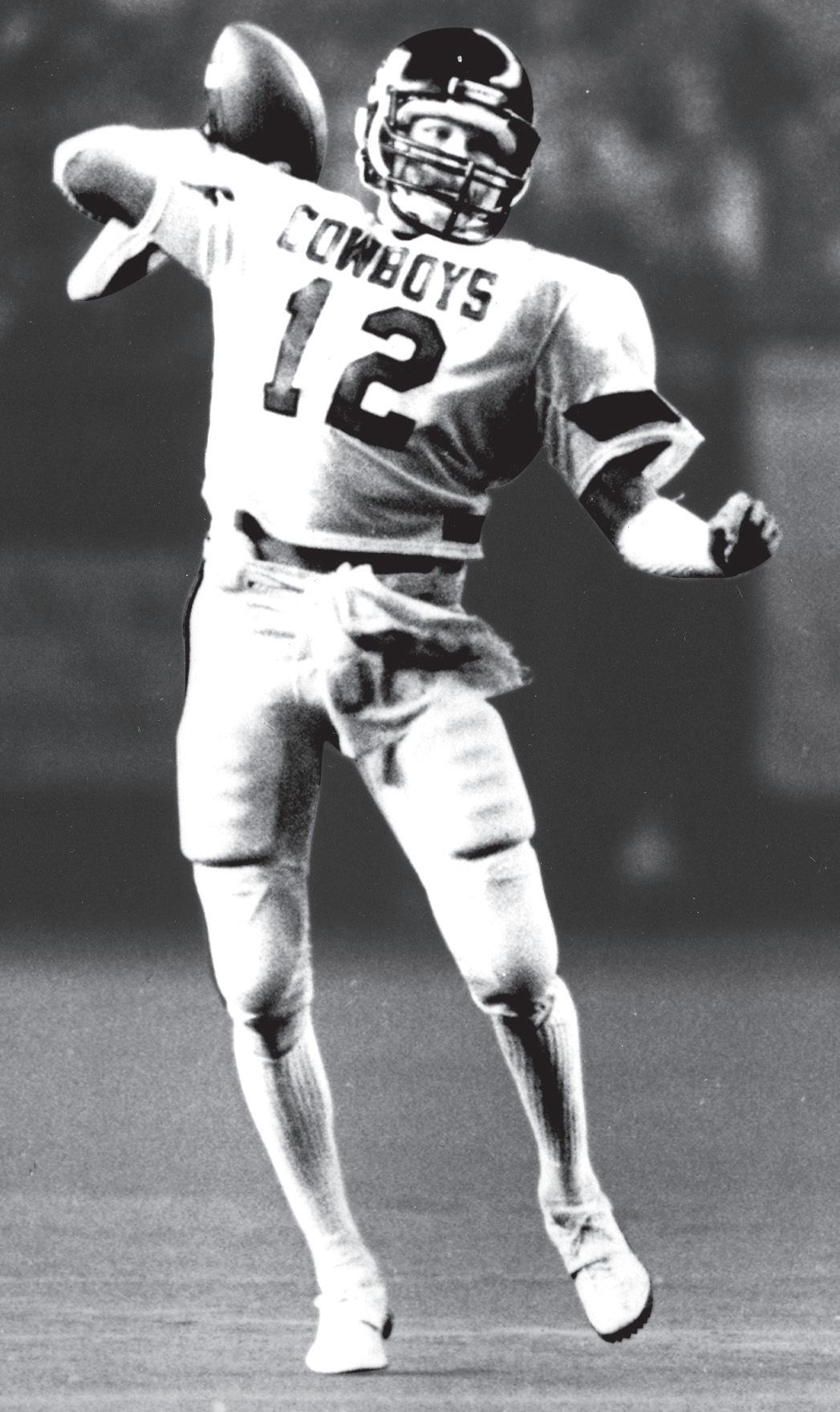
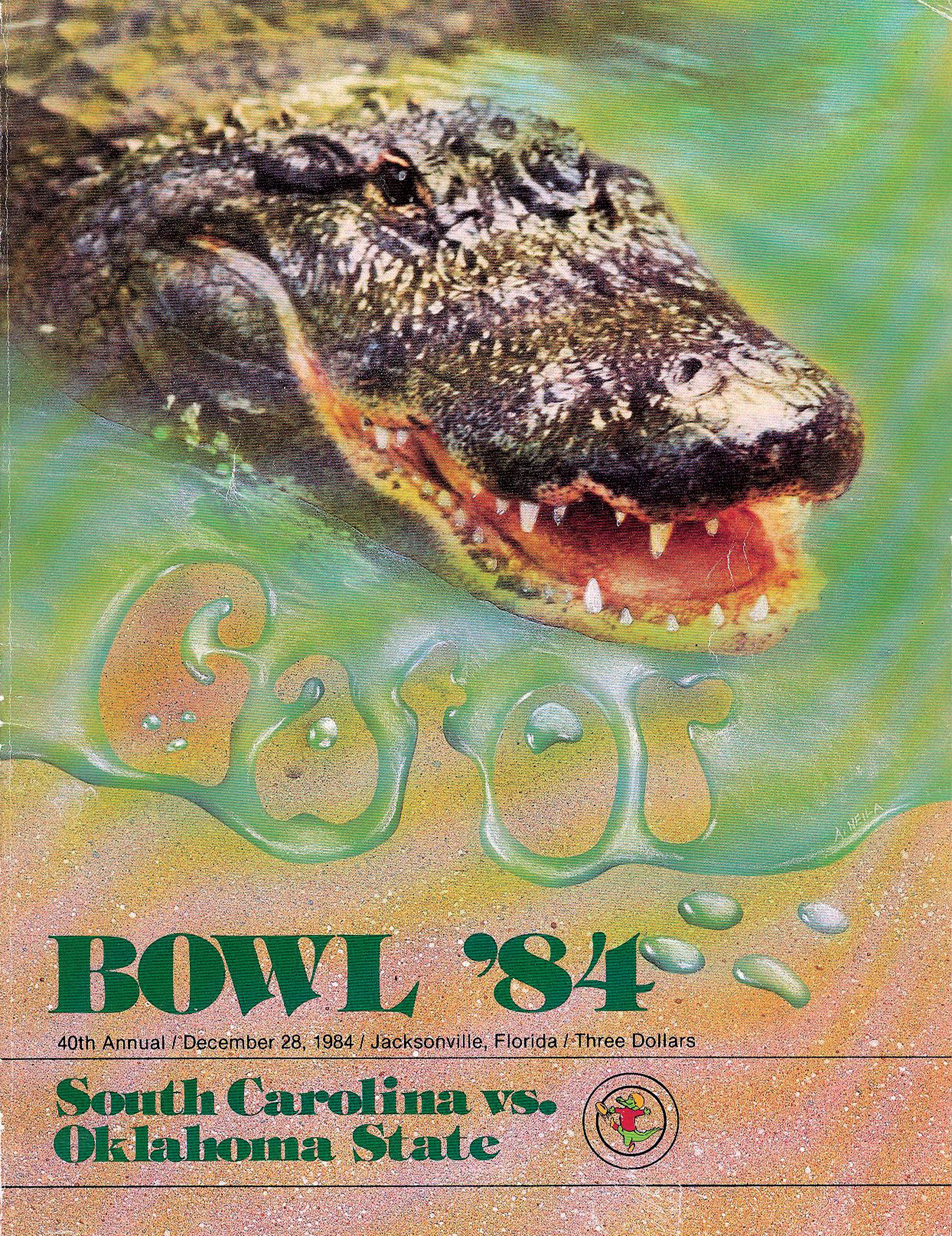
10-WIN MILESTONE
Arizona State Bowling Green San Diego State Tulsa Nebraska Kansas Kansas State Missouri Iowa State Oklahoma South Carolina 45-3 W 31-14 W 19-16 W 31-7 W 3-17 L 47-10 W 34-6 W 31-13 W 16-10 W 14-24 L 21-14 W
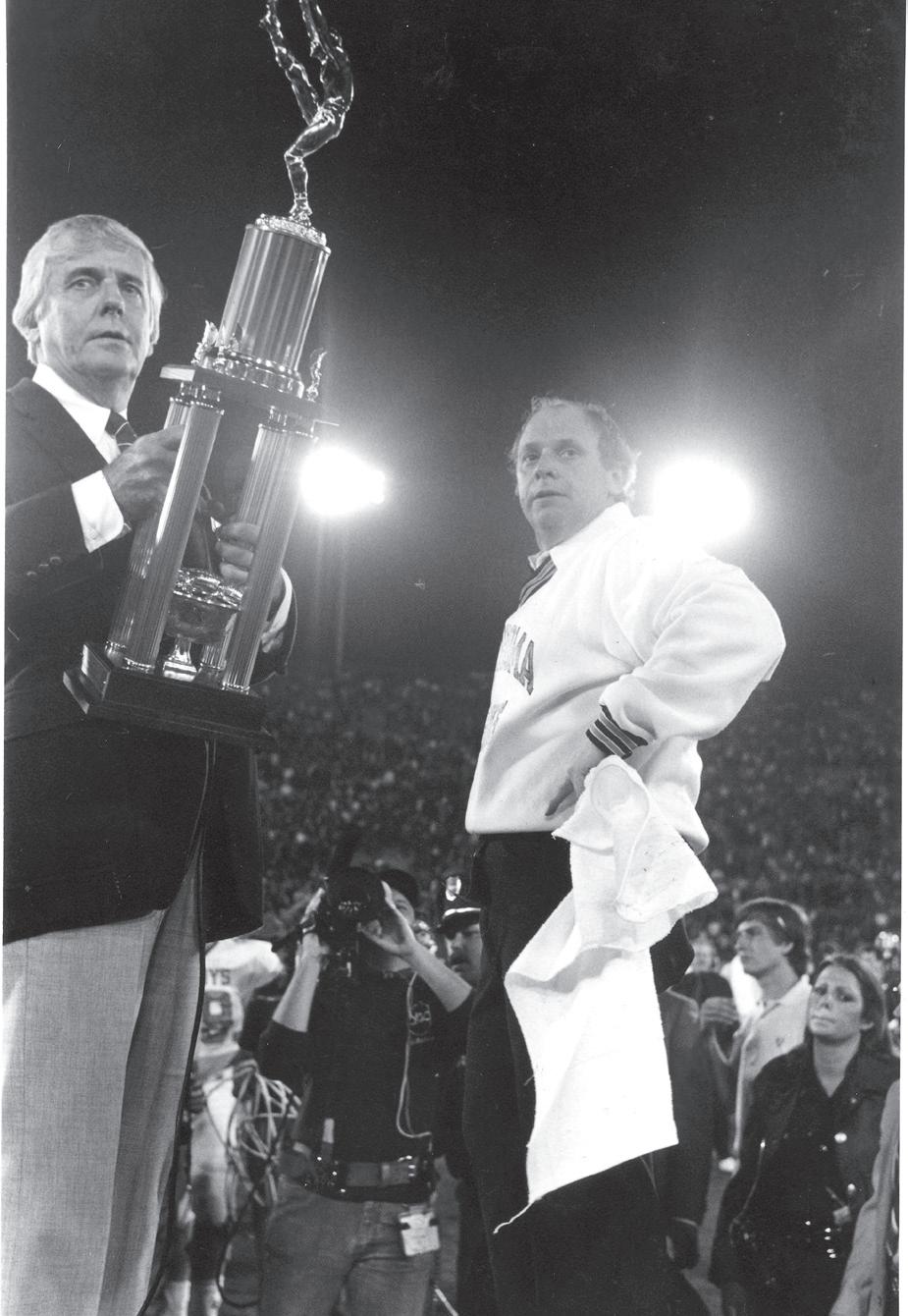
PAT JONES
The Iowa State victory also gave OSU its first nine-win season since 1976 and its first nine-win regular season since 1932. At that time no OSU team had ever won 10 games. The undefeated team of 1945 was 9-0, including its bowl win.
It was No. 2 against No. 3 in a high stakes game in Norman. At the time, it was billed as Oklahoma State’s most important football game ever played. As one would expect the margin of error was razor thin.
Oklahoma State committed two huge mistakes that enabled Oklahoma to win 24-14 and claim the conference title. A fumble at midfield and a controversial fumbled punt in the second half doomed Oklahoma State.
The Pokes, who finished second in the Big Eight, held an early 14-7 lead in the third quarter. A mishandled handoff gave OU a short field that produced a field goal. Early in the fourth, Bobby Riley appeared to be interfered with as he tried to handle a punt. He fumbled, OU recovered and cashed in the short field gift (25 yards) with a touchdown that turned out to be the difference. Hilger threw a pair of touchdown passes, but the running game could never get in gear against a rock-solid Sooner defense.
O’Neal had 13 tackles and three sacks, Monger added 16 tackles and Moore 10 more. OSU’s offense ended up with 198 total yards.
So, it was on to Jacksonville, Fla., where ninth-ranked Oklahoma State would meet seventh-ranked South Carolina in a high celebrity matchup. A Gator Bowl record crowd of 82,138 watched a classic.
OSU led 13-0 at halftime, but the Gamecocks came back with two third quarter TD passes and the teams headed into the final stanza with South Carolina on top 14-13.
What would take place in the game’s final 3:41 still ranks as one of OSU football’s finest moments. The Cowboys began “the drive” on their own 12-yard line. Hilger methodically moved the Cowboys down field. He saved the drive on third and 10 and again on fourth and six with a 13-yard pass to Barry Hanna that took the ball to the Gamecocks’ 36.
Thomas, who rushed for 155 yards and a touchdown and threw for another — and was named Gator Bowl MVP—gained 11 to the 25. Then came the play that Cowboy fans will always remember. Hilger scrambled away from two defenders, hit Hanna on the sideline at the seven, and the Cowboy senior, who had not scored a touchdown since his first year at OSU, banged off two tacklers, somehow stayed in bounds and carried three defenders into the end zone with 1:04 remaining. The Cowboys completed a two-point pass to go up 21-14.
But, there was still work to be done. It wasn’t until Demise Williams picked off a last-gasp South Carolina pass inside the Cowboy 30 with 37 seconds left could the celebration begin.
Both teams finished 10-2 on the year. Oklahoma State picked up its seventh bowl win in nine tries.
It was a fitting way to end one of the most incredible football seasons ever at Oklahoma State. So many storylines, so many big plays and so many big-time players who suited up for the Cowboys. The ’84 roster was jam-packed with All-Americans and future NFL stars. In my opinion, it was a team as talented from top to bottom as any you can find in the history of the program. It finished seventh that year in the polls and began a great five-year run.
“We knew we were good,” said Monger a number of years later. “I’m not sure at the time we knew just how good we were. It was a great experience playing with these guys, some of whom I played against in the league. It’s a season I’ll never forget.”
And neither will the loyal and true of Oklahoma State.

PHOTO BY GARY LAWSON






